Struggling to find the right LMS for your organisation? With so many options on the market, making the wrong choice can waste time, money, and training potential.
This guide will help you navigate the selection process with valuable information. We’ll take you through everything essential for informed decision-making, from key features to cost considerations.
We'll also explore how to match an LMS to some popular industry needs like hospitality or frontline training. Prepare for a comprehensive breakdown that cuts through the noise and equips you with the knowledge to make the best choice. Let’s begin!
LMS basics refresher: what is it and why does it matter for your business?
Before we discuss the multiple factors for choosing an LMS, it's helpful to review what an LMS is and how it can drive value for your business. Whether you’re new to the concept or need a quick refresher, this should be useful for later reference.
What is an LMS?
A Learning Management System (LMS) is a digital platform that manages, delivers, and tracks training and educational content. At its core, an LMS simplifies training employees (or other types of learners) by providing a centralised space for course management, learning content, assessments, and progress tracking.
An LMS is used by various industries, including hospitality, healthcare, transportation, retail, and corporate sectors to facilitate continuous learning, ensure compliance, and enhance workforce skills.
How do learning management systems add value to businesses?
Learning management systems offer businesses an efficient and scalable way to deliver training. Below are key ways LMS platforms can add value and drive performance improvements across various industries:
- Streamlines training processes: Consolidates training materials into one central hub, making it easier to manage, update, and distribute content efficiently.
- Content authoring flexibility: Provides tools for creating and customising training courses through multiple media formats, such as text, video, and interactive elements. Advanced LMS platforms can leverage AI-powered course creation, allowing quick content development and updates.
- Supports compliance: Offers built-in tracking for compliance training, certifications, and regulatory updates, helping businesses meet legal and industry standards.
- Enhances learning flexibility: It provides on-demand access to training materials, enabling employees to learn at their own pace, anytime, anywhere. For instance, front desk staff can complete customer service training modules during quiet shifts, while housekeeping teams can access new cleaning procedure updates in real-time.
- Improves performance tracking: Offers reporting and analytics tools to track learner progress and identify areas for improvement. A restaurant chain, for example, can track how well employees perform in customer service modules, allowing managers to determine who may need additional support or advanced training to improve guest satisfaction.
- Boosts employee engagement: Features like gamification, interactive content, and mobile learning access help keep employees engaged and motivated.
By implementing an LMS, businesses can create a structured, consistent training environment that adapts to evolving needs, making it a key asset in maintaining a skilled and compliant workforce.
Key factors to consider when picking an LMS for your training needs
With the abundance of options available, it's important to know what factors truly matter to meet your specific needs. This section breaks down the various LMS features, functionalities, and capabilities you may have to consider to find one that will best serve your business.
1. Features and functionality: core capabilities to drive training success
Choosing an LMS with the right features is essential for comprehensive training and compliance. Without these core functionalities, you risk poor engagement, wasted resources, and regulatory lapses. Here’s how to evaluate LMS options for the features that matter:
- Comprehensive course management: Look for an LMS that supports various content formats (video, text, interactive) and enables easy content updates, ensuring your training stays relevant and engaging.
- Progress tracking and reporting: Prioritise platforms that offer real-time tracking, analytics dashboards, and automated reporting to help monitor learner progress and compliance and identify knowledge gaps.
- Certifications and assessments: A platform that automates certification tracking, sends renewal reminders, and offers flexible assessment tools (quizzes, practical evaluations) can help maintain compliance without manual effort.
- Industry-specific features: Ensure the LMS includes tailored tools for your sector, like customer service training modules for hospitality or mobile-first access for deskless, frontline workers.
- AI and automation: Select an LMS that offers an advanced AI course creation tool to expedite content development and enhance training efficiency.
Nobina’s success story with Lingio: Leveraging AI to transform training material for 13,000 employees
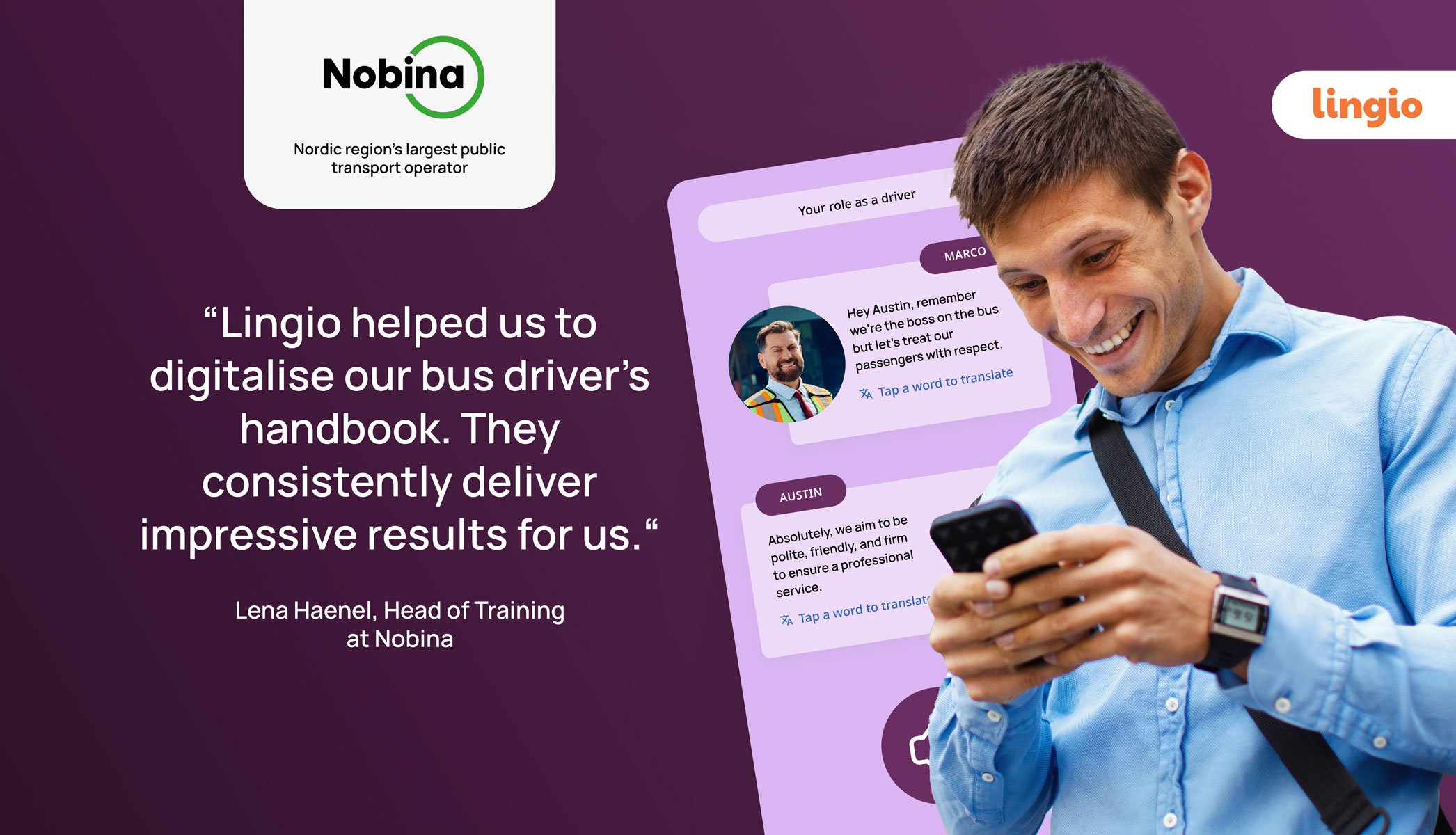
AI and automation in an LMS can dramatically boost efficiency, as seen in Nobina's case. As the Nordics' largest public transport operator, Nobina needed to train a diverse workforce quickly and effectively. Partnering with Lingio, they used AI-powered course creation to transform their traditional handbook into interactive, gamified mobile courses. This move significantly streamlined training, making it engaging and accessible for all staff.
With Lingio’s platform, Nobina quickly customised content and automated progress tracking, ensuring compliance and boosting operational efficiency. The ability to provide instant content updates in over 100 languages empowered their diverse workforce, driving higher engagement and faster skill development.
"Lingio helped us to digitise our bus driver's handbook. They consistently deliver impressive results for us," says Lena Haenel, Head of Training at Nobina.
2. Cost and pricing models: maximising value, minimising costs
Investing in an LMS is a significant decision and costs can quickly escalate if not carefully managed. Selecting the wrong pricing model can lead to unexpected expenses, making evaluating options based on your organisation's size, training needs, and long-term growth crucial. Here’s how to navigate LMS pricing effectively:
- Subscription vs. one-time fees: Subscription models typically charge monthly or annually and are ideal for businesses needing flexibility or those just starting. One-time fees may suit larger organisations that prefer a fixed, upfront investment without ongoing payments. Evaluate how long you'll use the LMS to determine the more cost-effective option.
- Pay-per-user pricing: This model charges based on the number of active users, making it scalable for growing businesses. However, it can become expensive if you have a large workforce. Consider pay-per-user pricing if your team size is manageable or if you plan to train a select group of employees.
- Hidden costs: Be aware of additional expenses such as setup fees, customisation costs, maintenance, and premium add-ons (e.g., advanced reporting features). Always request a detailed cost breakdown from the vendor to avoid surprises later on.
3. User experience and interface: the key to effective training adoption
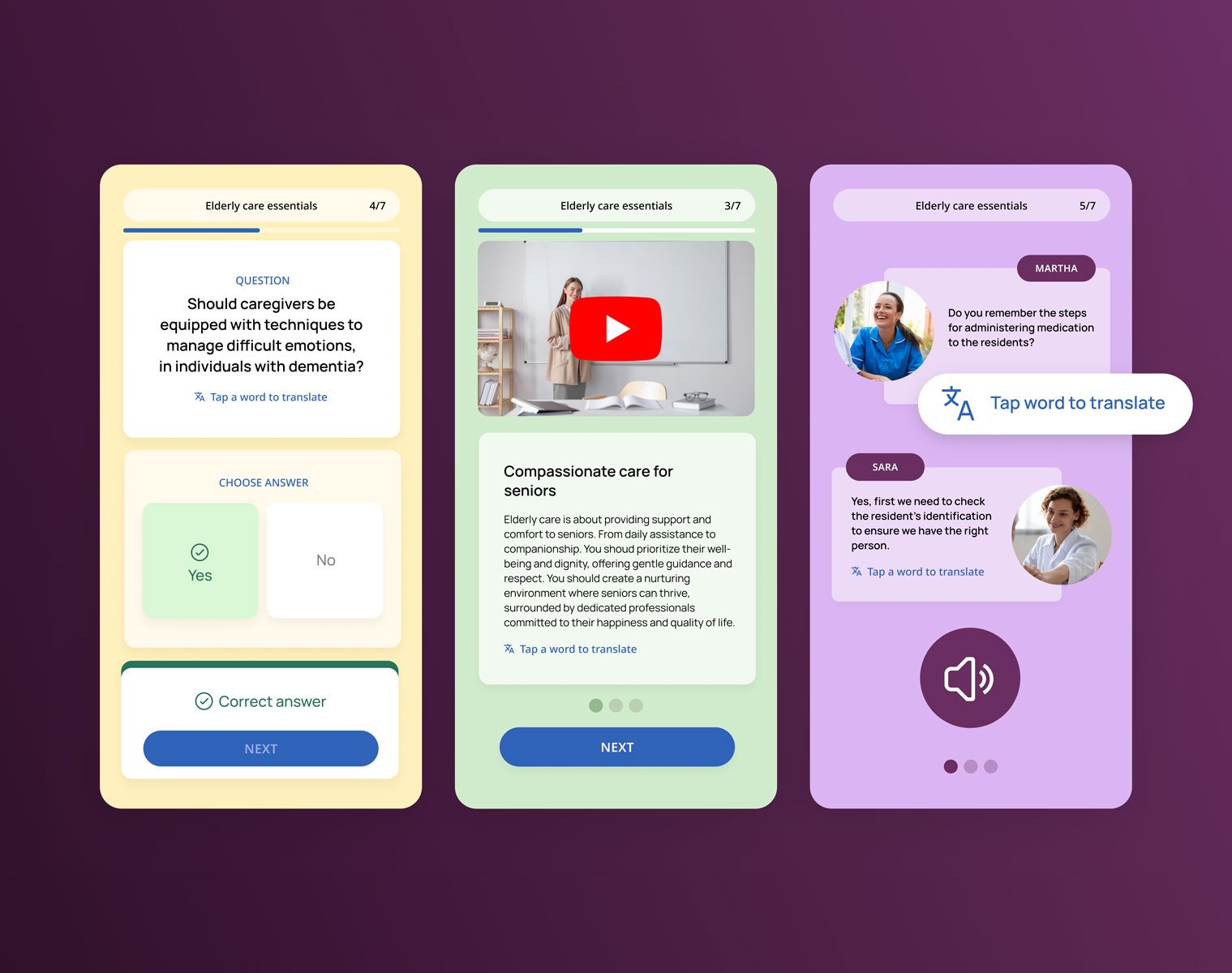
An LMS packed with features is pointless if it’s not user-friendly. A complex interface leads to frustration, low adoption rates, and ineffective training. Here’s how to ensure your LMS provides a seamless experience:
- Intuitive navigation: Choose an LMS with a simple, clutter-free interface that allows learners and admins to access courses and track progress with minimal effort.
- Mobile accessibility: Ensure the platform offers a responsive mobile design, enabling on-the-go training for employees, which is essential for industries with deskless workers.
- Customisable dashboards: Opt for dashboards that can be tailored to individual roles, giving learners and admins quick access to relevant tasks and progress metrics.
- Quick content search: Look for a platform with a robust search function so users can quickly find specific courses or resources, reducing time spent navigating the system.
4. Support and customer service: getting the help you need from your LMS provider
Even the most feature-rich LMS can fall short if reliable support and customer service aren't in place. Without prompt assistance, technical issues can disrupt training and waste valuable time. To ensure a smooth implementation and ongoing use, consider these factors when evaluating an LMS provider's support:
- Onboarding services: Choose a provider that offers hands-on onboarding to guide you through setup, customisation, and initial training. This helps your team get the most out of the system from day one.
- Responsive customer support: Look for a platform that provides multiple support channels - such as live chat, email, and phone along with guaranteed response times to address technical issues quickly.
- Self-service resources: Check if the LMS vendor includes access to a knowledge base, FAQs, webinars, and online communities. These resources empower your team to resolve common issues independently, saving time and reducing reliance on support staff.
- Dedicated account manager: Opt for a provider offering a dedicated account manager who understands your business needs and provides ongoing, personalised support and strategy advice.
5. Scalability: handling expansion and growing needs
As your business grows, your training needs will evolve. A system that cannot scale with you will lead to costly migrations and downtime. To avoid these pitfalls, choosing the right LMS that can handle an expanding workforce, diverse content, and new operational regions is crucial. Here’s how to ensure your LMS is built for growth:
- User capacity: Choose an LMS that allows unlimited or easily adjustable user numbers to support your growing team without excessive costs.
- Content library expansion: Look for a platform that accommodates a broad and diverse course library, including video, interactive modules, and third-party resources.
- Multilingual support: If you plan to expand into new regions, select an LMS that offers multilingual options to provide a personalised training experience for a diverse workforce.
- Customisation and upgrades: Consider solutions with modular features or add-ons, allowing you to implement new functionalities as your training needs evolve.
6. Compliance and certification: meeting standards effortlessly
Compliance isn't optional in highly regulated industries like healthcare, finance, and hospitality - it’s a necessity. Failing to meet industry standards can result in costly fines, legal issues, and reputational damage. Therefore, your LMS must include robust compliance training features to manage certifications and consistently meet regulatory requirements. Here’s how to evaluate a LMS for compliance capabilities:
- Certification management: Choose a compliance training LMS that generates and manages certifications, ensuring employees stay up to date with mandatory regulations.
- Audit-ready reporting: Prioritise platforms offering detailed reports that simplify compliance during audits, providing clear data on course completions, certifications, and assessment outcomes.
7. Security and data privacy: safeguarding your training data
In an era where data breaches are increasingly common, securing employee data and maintaining privacy is non-negotiable. An LMS handles sensitive information, such as personal details, progress records, and certifications. Strong security measures are crucial to prevent data breaches, legal issues, and loss of trust. Here’s what to look for to ensure your LMS keeps your data secure:
- Data encryption: Ensure the LMS uses robust encryption (both in transit and at rest) to protect personal data and training records from unauthorised access.
- Access control: Opt for an LMS with role-based access controls, allowing you to limit who can view, edit, or manage sensitive information, minimising the risk of data misuse.
- Secure login options: Look for features like two-factor authentication (2FA) to enhance login security, making it harder for unauthorised users to gain access.
- Data backup and recovery: Check if the LMS includes regular data backups and recovery options to protect against data loss, ensuring business continuity in case of system failures.
8. Reporting and analytics: measuring training success
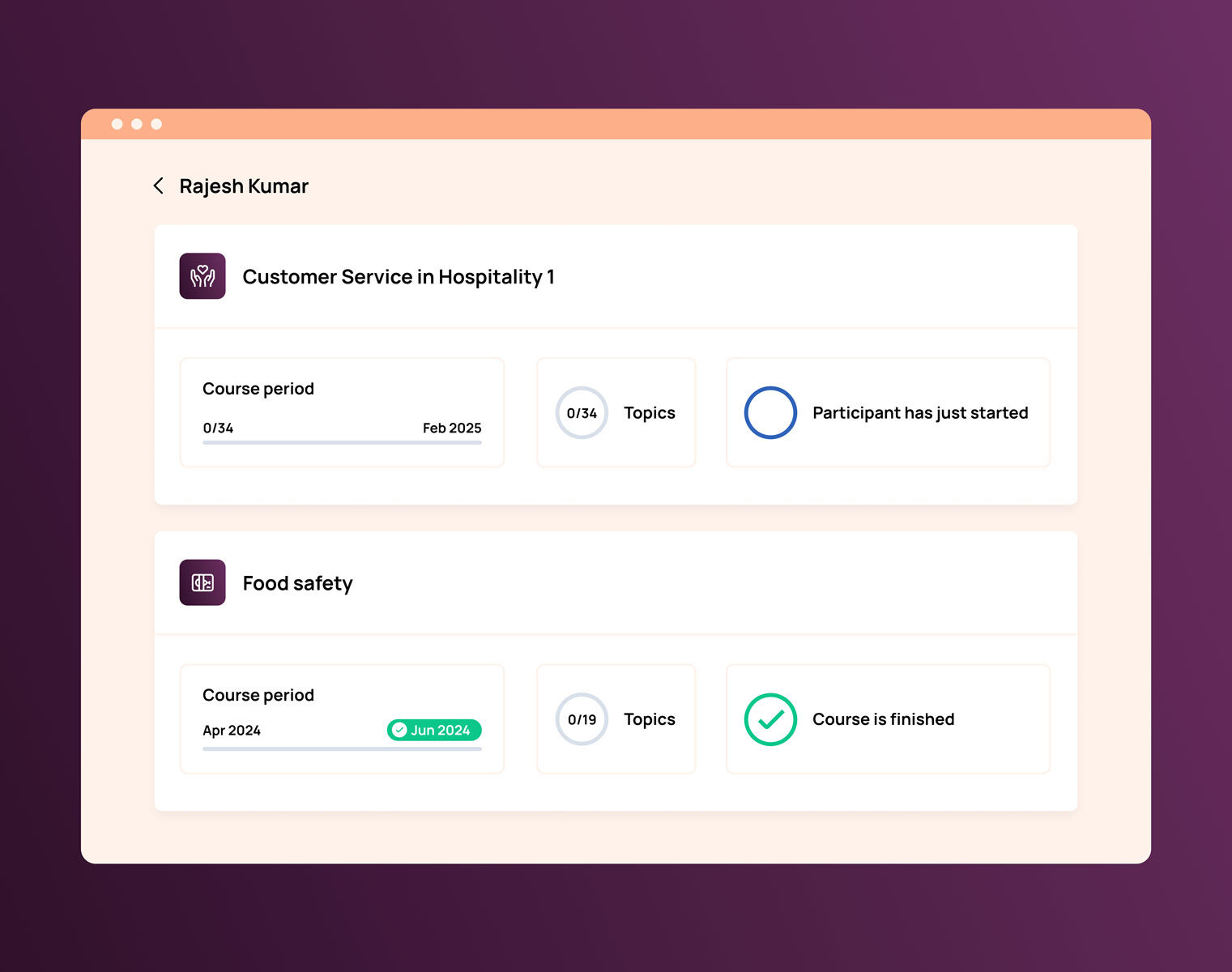
A robust LMS for employee training should provide more than just content delivery - it should offer insights into how learners engage and progress. Without robust reporting and analytics, it’s difficult to identify gaps, measure the impact of your training programmes, or make data-driven decisions for improvement. Here’s how to evaluate your LMS for its reporting and analytics capabilities:
- Real-time data tracking: Select an LMS that tracks learner progress, completions, and performance. This allows you to quickly identify employees who may need additional support or intervention.
- Custom reporting: Look for platforms that let you generate customised reports, filtering data by user groups, course types, or specific timeframes. This flexibility helps you measure the effectiveness of different training programmes and align them with business goals.
- Predictive analytics: Advanced LMS platforms use predictive analytics to identify future learning trends, anticipate skill gaps, and recommend targeted training. This feature allows you to address workforce development needs proactively.
9. Integration capabilities: building a seamless learning ecosystem
When selecting an LMS, consider whether integration with your current systems is essential or if a standalone solution will meet your needs. If integration is crucial, explore the system’s compatibility and compliance options to ensure a smooth, unified learning experience. Note: Integration options are available in our professional and custom pricing plans.
If you’d like to integrate, here’s what to prioritise:
- Compatibility with existing systems: Choose an LMS that integrates with HR, payroll, and CRM platforms to automate tasks like employee record updates and role-based course assignments.
- Third-party content integration: It's useful to have an LMS that supports popular e-learning libraries, allowing you to easily enrich your training programs with industry-standard courses.
- SCORM and xAPI compliance: Consider an LMS that follows these compliance standards, enabling seamless import, export, and tracking of courses across different platforms.
10. Content library and resources: fueling effective learning
The success of your training programme depends on the quality and variety of learning content. An LMS with limited resources can result in repetitive and uninspiring training. Ideally, your LMS should make it easy to get started with training and provide flexibility for content creation. Here’s what to look for:
- Quick-start content: An LMS should help you get started fast by offering pre-built courses designed by experts. For example, Lingio provides ready-to-share courses on topics like workplace well-being and cybersecurity, allowing you to train staff efficiently without building content from scratch.
- Third-party content integration: An LMS that supports integration with your HRIS and workforce management systems that enriches your training by adding diverse, industry-standard content.
- Content creation tools: Platforms with built-in authoring tools, including text, video, quizzes, and interactive elements, streamline content development. Lingio’s AI-driven course creation simplifies this process, allowing rapid development of tailored training modules.
11. Flexibility and adaptability: catering to every learning need
Training needs can vary significantly across different roles, locations, and industries. An inflexible LMS limits how you deliver training, making it challenging to engage a diverse workforce. Selecting a platform that supports various learning formats and adapts to changing requirements is crucial. Here’s what to consider:
- Blended learning support: An LMS that accommodates both online and offline learning provides flexibility. This allows employees to engage through virtual courses or in-person sessions, ensuring a seamless experience regardless of their environment.
- Gamification features: Gamification elements, such as badges, points, and leaderboards, can significantly boost engagement and motivation. This makes learning enjoyable and helps retain crucial knowledge.
- Customisable learning paths: An adaptable LMS should allow tailored learning paths based on job roles, skill levels, or training goals. This personalisation ensures relevant and focused learning that meets individual needs.
12. Vendor reputation and longevity: choosing a reliable partner
An LMS is a long-term investment; your vendor's stability can directly impact your organisation’s training success. A provider with a poor track record or lacking consistent support can lead to interruptions, outdated tools, or even service discontinuation. To safeguard your investment, consider the following when evaluating LMS vendors:
- Proven track record: A vendor with a strong history in the LMS market and positive client testimonials reflects experience and reliability in delivering effective solutions. This indicates a level of trustworthiness and industry expertise. For example, if you're based in the UK, researching LMS providers in the UK with long-term success stories and trusted local partnerships can be a valuable indicator of quality.
- Regular product updates: Vendors that actively improve their platform with regular updates and new features show a commitment to innovation and adapting to industry trends, helping ensure your LMS stays relevant.
- Client retention: High client retention rates often signal a vendor’s ability to meet diverse needs and provide lasting value. Reviewing case studies or long-term partnerships with similar organisations can offer insights into their quality of service.
Tailored advice: finding the right LMS for specific training needs
While we've covered the core factors for selecting an LMS, diving deeper into specific use cases is equally important. Whether managing customer-facing roles, ensuring compliance, or training a mobile workforce, an industry-focused approach ensures your learning solution effectively meets real-world challenges.
Let’s explore some popular training scenarios and provide focused advice on finding the best learning management system for each situation.
How to choose an LMS system for the hospitality sector
In hospitality, the stakes are high regarding customer experience and staff performance. A suitable LMS must facilitate rapid onboarding, consistent customer service standards, and health and safety regulations compliance. Here's what to focus on:
- Shift-based learning: A hospitality-specific LMS should allow training assignments based on shifts so employees can complete courses during their downtime without affecting guest service.
- Role-specific training: A hospitality-focused LMS might provide pre-built modules tailored for different roles, such as front desk, housekeeping, and food service. This allows employees to receive targeted, relevant training specific to their job functions.
- Multilingual support: Hotels often employ staff from diverse backgrounds. An LMS with multilingual support enables employees to learn in their preferred language, enhancing comprehension and engagement.
How to choose an LMS for compliance training
Compliance training is crucial for industries like healthcare, finance, and manufacturing. A well-suited LMS should streamline the process and keep your organisation audit-ready. Here’s what to prioritise:
- Automated certification tracking: Opt for an LMS that can offer certifications, send renewal reminders, and generate audit-ready reports.
- Custom compliance content: Look for an LMS that lets you create and update courses tailored to regulations like GDPR, HIPAA, or OSHA.
- Policy acknowledgements: The LMS should include features to track employee acknowledgements of key policies, creating a clear audit trail.
How to pick the best LMS for frontline training
Frontline healthcare, retail, transportation, and hospitality workers need quick, accessible training solutions. Traditional learning methods often don’t work for these roles, as frontline staff are often on the move with limited time. A suitable LMS software for frontline training should focus on accessibility, engagement, and real-time updates. Here's what to consider:
- Mobile-first design: Frontline workers need training on the go. An LMS that’s fully mobile-compatible allows staff to access learning materials directly from their smartphones, fitting training into their busy schedules.
- Microlearning: Short, bite-sized modules are ideal for busy employees. An LMS that supports microlearning breaks down complex topics into manageable segments that can be completed in minutes.
- Gamified learning: An LMS with gamification features like quizzes, badges, and leaderboards makes training more interactive, promotes social learning and boosts engagement. This motivates staff to complete courses.
Why is Lingio a top choice for frontline training?
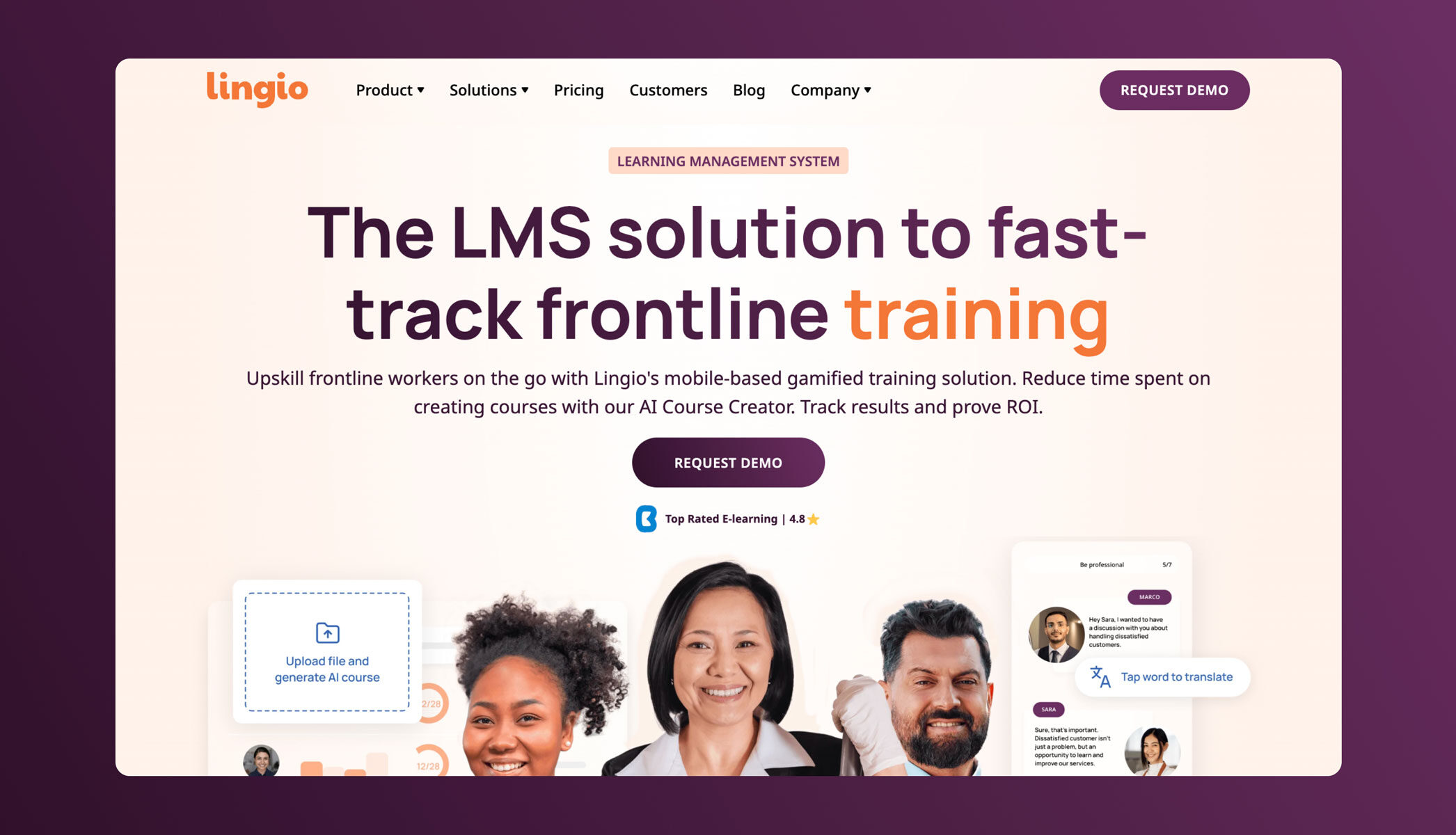
Lingio LMS is explicitly designed for frontline workers, offering a mobile-first, AI-powered platform tailored to fit the hectic schedules of deskless staff. Here's how Lingio meets the unique requirements of frontline training:
- Flexible and accessible training: Lingio’s mobile learning app enables staff to access training anytime, anywhere. The gamified, interactive microlearning modules fit seamlessly into daily workflows, minimising disruptions.
- Multilingual support: With translations for industry terms in over 100 languages, Lingio ensures that all frontline workers, regardless of language proficiency, can effectively engage with the training content.
- AI-driven course creation and customisation: Lingio's AI Course Creator converts internal training documents into engaging, mobile-optimised courses within minutes. It also offers ready-to-use courses and editable templates, allowing easy customisation to meet specific training needs.
- Tracking and admin portal: Through the Tracking and Coaching Portal, managers can distribute courses, monitor progress, and send automated reminders. This ensures that teams stay on track and engaged in their learning journey.
With its mobile-first design, AI-driven course creation, and robust tracking features, Lingio delivers an efficient, engaging training experience tailored to the fast-paced world of frontline work.
Some LMS implementation tips
Selecting the right learning management system is just the beginning. Proper implementation is crucial to unlocking its value and seeing actual results. Here are practical tips to ensure your LMS is set up for success and fully utilised by your team.
- Set clear goals and timelines: Define your learning objectives and plan a detailed rollout schedule with clear milestones and responsibilities.
- Run a pilot test: Test the LMS platform with a small group to identify issues and gather feedback, allowing for adjustments before the full launch.
- Customise training content: Use internal materials and tools like Lingio to tailor courses for your specific needs quickly.
- Train your admins: Ensure LMS administrators are well-trained to manage the platform, which will enable a smoother employee onboarding process and fewer issues.
- Simplify employee onboarding: Create an intuitive onboarding experience, making it easy for staff to access courses and track their progress.
By taking a structured approach and ensuring early engagement, your LMS implementation will deliver the full potential of your training platform and drive meaningful impact across your organisation.
Let your needs guide your LMS choice
Selecting the right LMS can transform your organisation’s training programs, but aligning the learning platform with your specific needs is essential. We’ve explored key factors like features, pricing, integration, and scalability - all critical for ensuring your LMS supports your long-term goals. Whether you’re focused on improving customer service in hospitality, ensuring compliance in regulated industries, or training a mobile, deskless workforce, these elements should guide your decision.
Lingio stands out as an excellent solution for businesses with frontline training needs. Its mobile-first design, AI-powered course creation, and multilingual support are perfect for engaging busy, on-the-go employees. Request a demo with one of our learning specialists today to discover how Lingio can supercharge your training programs.
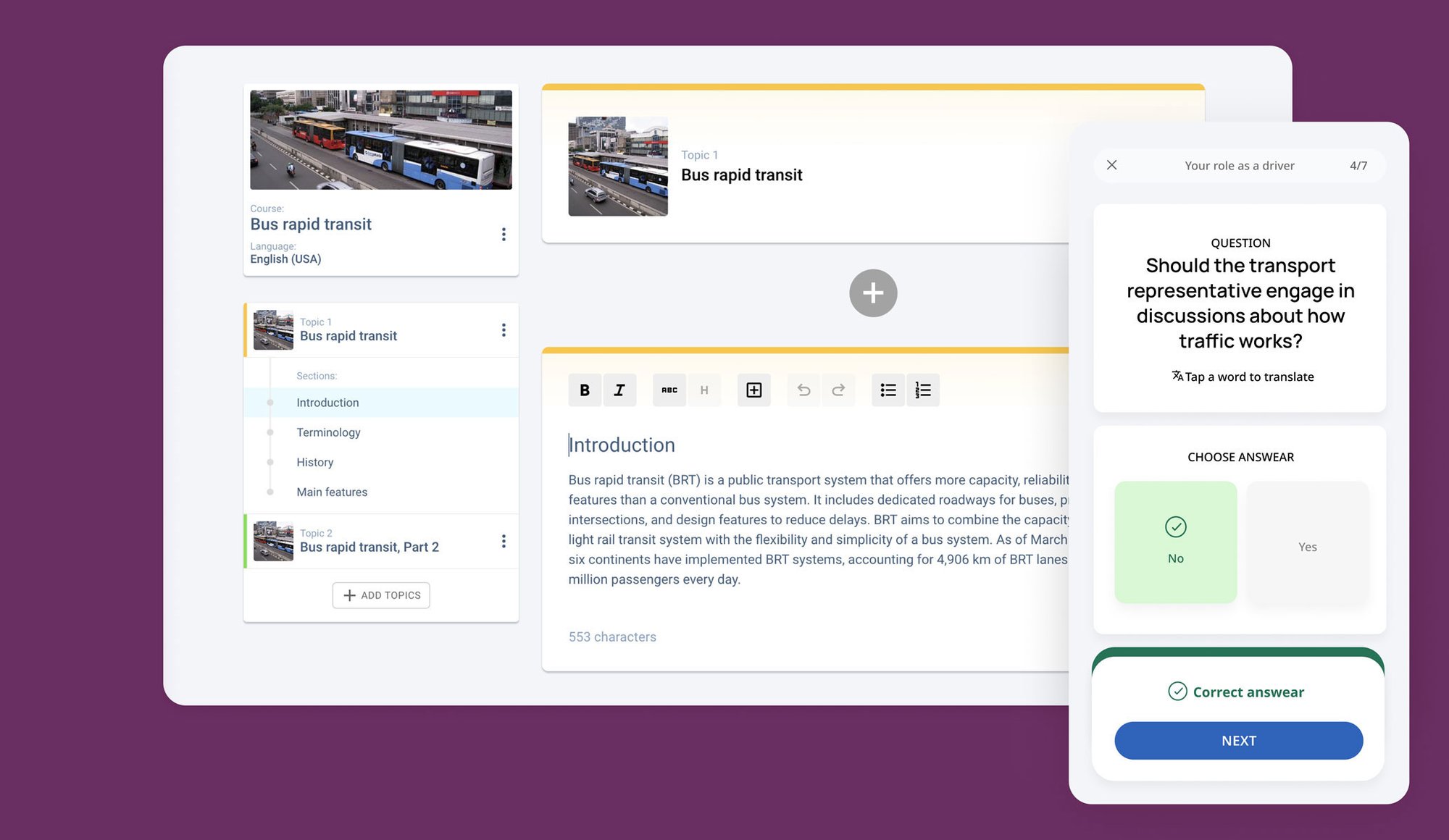

Table of contents
Intro
LMS basics refresher: what is it and why does it matter for your business?
Key factors to consider when picking an LMS for your training needs
Tailored advice: finding the right LMS for specific training needs
Some LMS implementation tips
Let your needs guide your LMS choice

